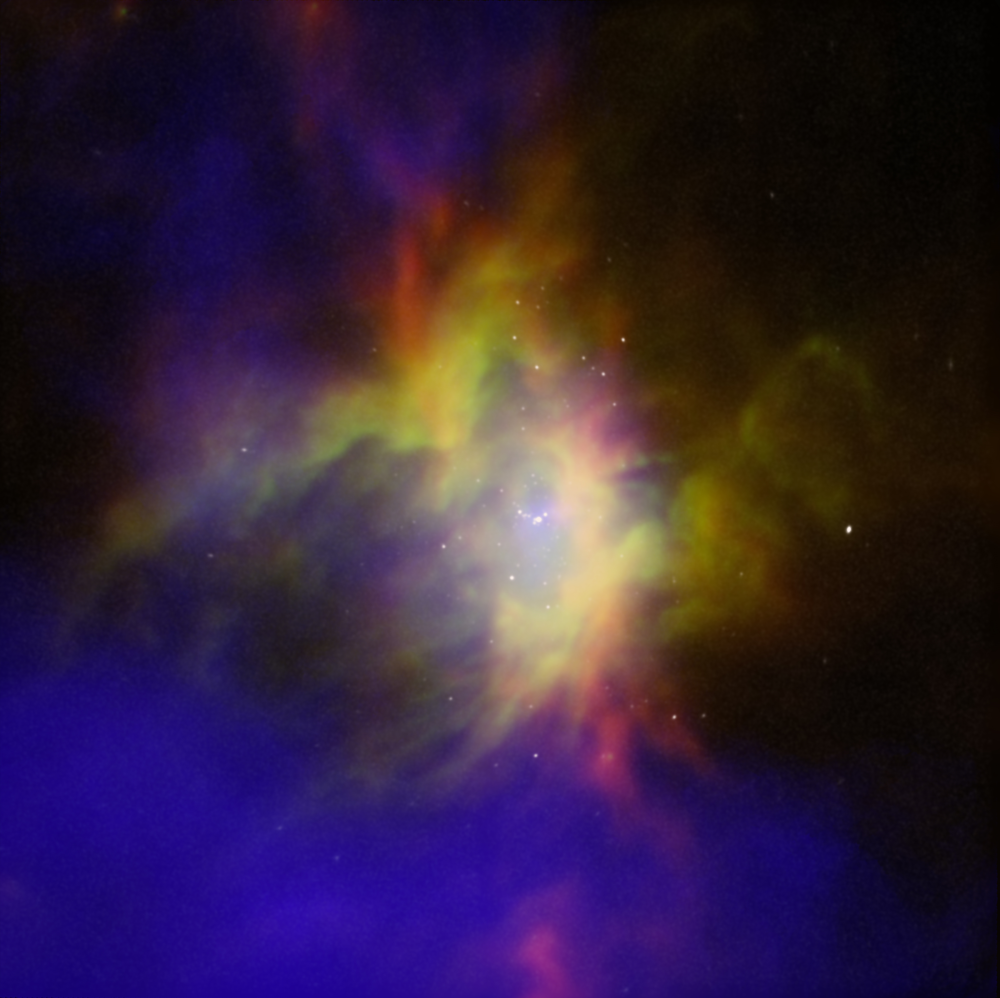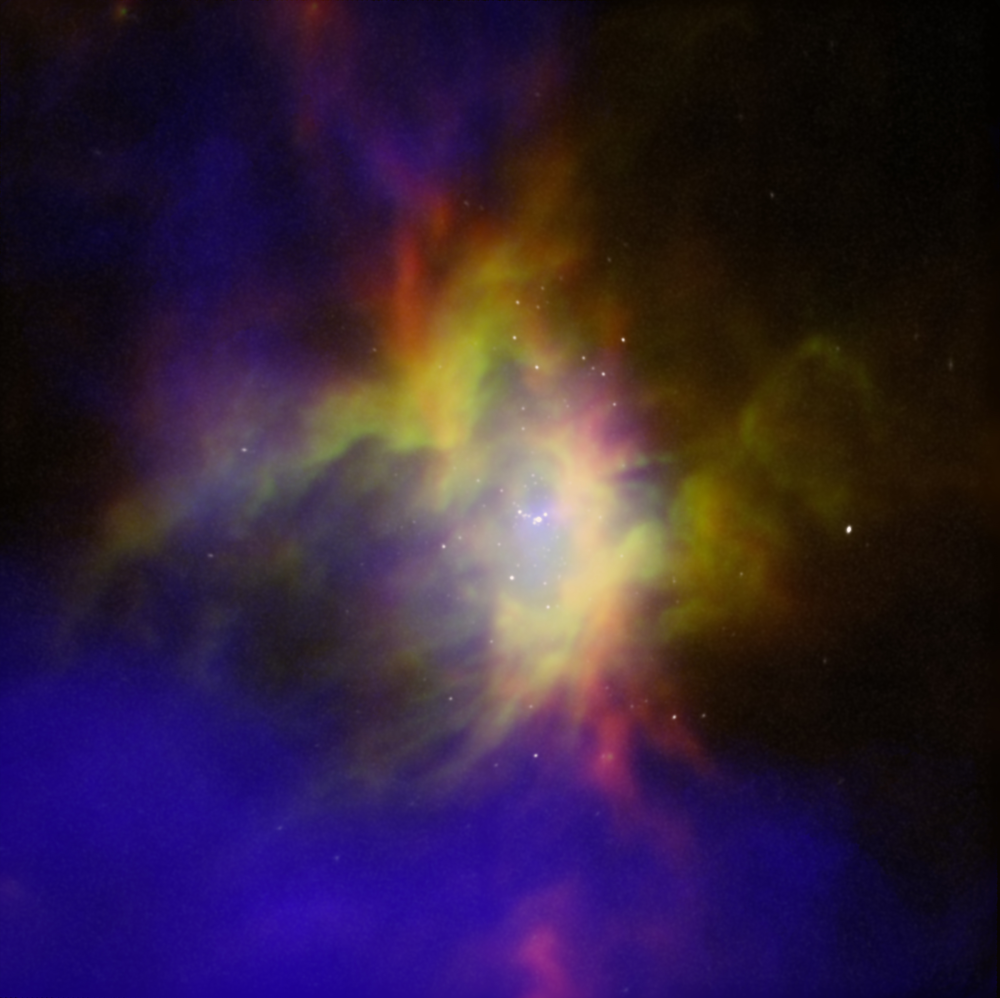Massive Star Formation Displays Self-Control
When it comes to star formation in interstellar clouds of gas and dust, there’s an ongoing tug-of-war between two cloud-shaping processes. Young, massive stars inject energy into their surroundings in a way that both disrupts star formation by shredding the surrounding medium and encourages it by collecting dense gas shells that are prone to gravitational collapse. Which of these feedback processes dominates has been unclear, but new observations by Lars Bonne of Universities Space Research Association at NASA Ames and his colleagues suggest that stellar feedback significantly suppresses star formation. These findings—presented earlier this month at the 241st Meeting of the American Astronomy Society in Seattle—provide a missing piece in understanding why proposed rapid star-formation rates have long misaligned with observations.
Recent observations suggest that the formation of high-mass stars—ones greater than 8 times the mass of the Sun—is associated with the gravitational collapse of the surrounding cloud of molecular gas. This collapse leads to a high concentration of material, which should induce further star formation. However, the expected high star-formation rates are not observed, with typically only a few percent of the molecular cloud’s mass becoming new stars. “If stellar feedback indeed disperses the collapsing molecular cloud on the same timescale that new stars form, it could prevent these proposed high star-formation rates,” Bonne says. But predicting the impact and role of stellar feedback on the surrounding molecular cloud remains extremely difficult.
Now with data from NASA’s Stratospheric Observatory for Infrared Astronomy (SOFIA, now retired) and the Chandra X-ray Observatory, Bonne and his colleagues have tracked the process in real time. The first observation target was a star-forming complex called RCW 36, which is several light-years across and is located 2900 light-years away in a molecular cloud within the constellation Vela. Like other star-forming complexes, RCW 36 consists of a large region of ionized atomic hydrogen (HII, pronounced “H-two”). This region includes a cluster of young stars and two low-density cavities that extend outward in opposite directions. A ring of gas forms a waist between the two cavities, resulting in an hourglass-like shape.
At the interface of the HII region and its neutral interstellar surroundings, a spectral line from ionized carbon (CII) traces the cooling gas shells. By tracking this infrared line with instruments onboard SOFIA, Bonne’s team could map the changing dimensions of RCW 36’s features, as well as follow material ejected by the cluster’s largest stars. This high-resolution mapping revealed expanding cavity shells in addition to a slowly expanding waist and high-velocity flows of cool gas within the cavities. “Because CII is such a unique tracer of the impact of stellar feedback on interstellar clouds, this is one of the first times we have direct observational evidence of this [expansion],” Bonne says.
The researchers complemented the CII observations with x-ray maps from Chandra that revealed hot plasma both inside and outside of the cavities. The combined data helped paint a picture of the feedback process in terms of hot gas concentrated near the center of RCW 36, where the cluster’s two hottest and largest stars are located. Pressure from this hot gas can drive high-velocity mass ejection that disperses the observed molecular clouds on timescales of just a few million years. “This is what we call self-regulation by stellar feedback,” says Bonne.
Bonne and his team are now studying other molecular clouds that have different stellar environments, evolutionary ages, and formation activity. Their observations so far provide a consistent framework to start understanding the detailed physics of high-mass-star formation in galaxies. In RCW 79, an HII region in the constellation Centaurus that is 10 times bigger than RCW 36, mass is ejected at a similar velocity to its smaller counterpart—evidence of a similar self-regulating pattern. In both cases, Bonne explains, some gas still collects in the star-forming region. But mass ejection dominates, indicating that the molecular clouds will eventually disperse into diffuse gas and become part of the interstellar medium. The team estimates cloud dispersal times of 1 to 5 million years, which is consistent with indirect statistical measurements of cloud lifetimes in nearby galaxies.
With a clearer idea of the duration that star-forming regions remain active, researchers may now build better models of the early history of galaxy formation—and how molecular clouds contribute to the interstellar medium over time. “These types of molecular-cloud studies will be an instrumental benchmark to start understanding how the first stars formed in the early Universe,” says Bonne.
–Rachel Berkowitz
Rachel Berkowitz is a Corresponding Editor for Physics Magazine based in Vancouver, Canada.





